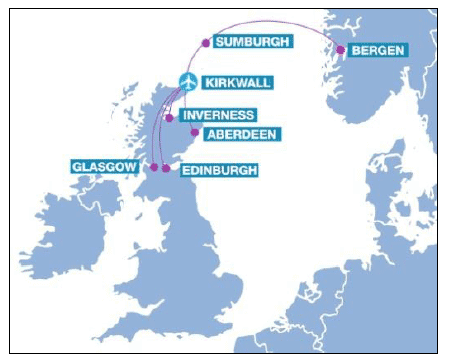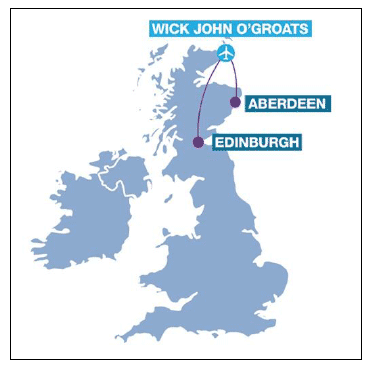Pilot Pentland Firth and Orkney Waters Marine Spatial Plan - Socio-Economic Baseline Review
This Socio-Economic Baseline Review provides a regional overview of the Pentland Firth and Orkney Waters area for the pilot Pentland Firth and Orkney Waters Marine Spatial Plan. It also informs the Sustainability Appraisal for this Plan.
5 Aviation
5.1 Spatial Extent and Intensity of Activity and Interests
5.1.1 Highland and Islands Airports Limited ( HIAL) manages 11 Scottish Airports, 2 of which are within and adjacent to the PFOW area; Kirkwall Airport and Wick John O'Groats. Kirkwall airport is the main airport servicing the Orkney Islands. Flights are available from the Scottish Mainland, Shetland and Norway. Through a franchise partnership with Flybe, Loganair operate services to Inverness, Aberdeen, Glasgow, Edinburgh, Sumburgh and Shetland, as well as some internal island 'hops' to Sanday, Stronsay, Eday, Westray, Papa Westray, North Ronaldsay and Fair Isles (Figure 4).
Figure 4 Kirkwall Airport destinations [22]

5.1.2 Kirkwall Airport offers the quickest means of getting to Orkney from Edinburgh, Aberdeen, Inverness and Glasgow and is an important transport link for business and leisure tourism.
5.1.3 Wick John O'Groats Airport is the most northerly airport on the Scottish Mainland, which connects rural communities in the north of Scotland with Aberdeen and Edinburgh (Figure 5). It is an important hub for oil and gas operations in Caithness.
Figure 5 Wick John O'Groats destinations [23]

5.2 Economic value and employment
5.2.1 HIAL airports support the vital air links to otherwise remote communities across the Highlands and Islands, including the provision of Scottish Air Ambulance and Search and Rescue services. HIAL operate at a loss and are supported by subsidies from the Scottish Government. The airports also serve the economic and commercial interests of regional Scotland, supporting oil and gas helicopter operations, lighthouse maintenance and Royal Mail services. Table 13 summarises the volume of the annual aircraft and passenger movement from Kirkwall and Wick Airport.
Table 13 Total passenger and aircraft movement for Kirkwall and Wick Airport [23]
| Total Passenger Movement | Aircraft Movement | |||||
|---|---|---|---|---|---|---|
| 2013/14 | 2012/13 | 2011/12 | 2013/14 | 2012/13 | 2011/12 | |
| Kirkwall | 177,899 | 164,228 | 158,616 | 14,651 | 14,122 | 14,004 |
| Wick | 41,281 | 33,921 | 28,876 | 7,378 | 6,001 | 4,976 |
*Total passengers consist of arriving and departing terminal and transit passengers (Highlands and Islands Airport Limited, 2013) [24]
5.2.2 There are 57 staff employed at Kirkwall Airport and 42 at Wick John O'Groats Airport. The breakdown of employment by job role is summarised in Table 14.
Table 14 Airport staff employment, 2014 [23]
| Admin | Airport Fire Service | Air Traffic Control | Engineering | Security | Manager | Total | |
|---|---|---|---|---|---|---|---|
| Kirkwall Airport | 2 | 21 | 12 | 3 | 18 | 1 | 57 |
| Wick John O'Groats Airport | 2 | 18 | 7 | 1 | 14 | 0 | 42 |
5.3 Historic and future trends
5.3.1 The data available shows a rise in both passenger and aircraft movements over the last few years. Given that at a national level there is a high propensity to fly [25] and a lack of viable alternatives for island communities it seems to assume that this trend will continue in the future for Kirkwall, resulting in a gradual increase in movements. Wick passenger numbers have fluctuated over the last ten years and are more dependent on the quantity of oil sector related opportunities that the airport is able to capture within the region. Highland and Islands Airports have no expansion plans at present.
5.4 Data Gaps and Limitations
5.4.1 There is a lack of spatial and economic information on aircraft and helicopter routes. The information available on passenger movement gives an indication as to the importance of these airports to local communities.
Contact
There is a problem
Thanks for your feedback